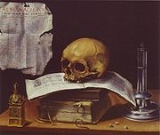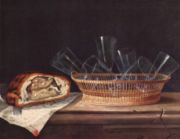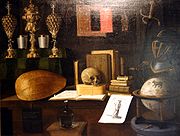
Sebastian Stoskopff
Encyclopedia



Alsace
Alsace is the fifth-smallest of the 27 regions of France in land area , and the smallest in metropolitan France. It is also the seventh-most densely populated region in France and third most densely populated region in metropolitan France, with ca. 220 inhabitants per km²...
painter. He is considered one of the most important German
Germany
Germany , officially the Federal Republic of Germany , is a federal parliamentary republic in Europe. The country consists of 16 states while the capital and largest city is Berlin. Germany covers an area of 357,021 km2 and has a largely temperate seasonal climate...
still life
Still life
A still life is a work of art depicting mostly inanimate subject matter, typically commonplace objects which may be either natural or man-made...
painters of his time. His works, which were rediscovered after 1930, portray goblets, cups and especially glasses. The reduction to a few objects, which is characteristic of early still life painting, can again be recognized in Stoskopff's painting. His chief works hang in Strasbourg and in Saarbrücken
Saarbrücken
Saarbrücken is the capital of the state of Saarland in Germany. The city is situated at the heart of a metropolitan area that borders on the west on Dillingen and to the north-east on Neunkirchen, where most of the people of the Saarland live....
.
Life
Sebastian Stoskopff was born in 1597 in StrasbourgStrasbourg
Strasbourg is the capital and principal city of the Alsace region in eastern France and is the official seat of the European Parliament. Located close to the border with Germany, it is the capital of the Bas-Rhin département. The city and the region of Alsace are historically German-speaking,...
. His father was employed by the city since 1590 and acted as a mounted courier or royal escort, driving a one-horse carriage. In 1614, Stoskopff's father asked the Strasbourg council for help for his 17-year-old son. He wanted him to be able to learn the craft of painting, since Sebastian had already been extremely talented in drawing and painting since he was 15. The council agreed to provide their support and probably sent the young artist at first to the Strasbourg painter and copper engraver, Friedrich Brentel
Friedrich Brentel
Friedrich Brentel, a German printmaker in engraving and etching, and miniature painter, was born at Laugingen in 1580, and became a citizen of Strasbourg in 1601. His principal work is a set of plates for 'The Funeral of Charles III, Duke of Lorraine,' and the Royal entry of his son as the new...
. However, he only learned how to further refine his drawing and was not, as hoped, introduced to the art of painting.
In 1615, Stoskopff's father died and his widowed mother went to the Strasbourg council once again to ask for support for training from a recognized painter. Stoskopff was then sent to Daniel Soreau, a painter who was active in Hanau
Hanau
Hanau is a town in the Main-Kinzig-Kreis, in Hesse, Germany. It is located 25 km east of Frankfurt am Main. Its station is a major railway junction.- Geography :...
. In the beginning, Soreau was not very enthusiastic, since he usually chose his apprentices from among his relatives and close friends. However, he finally complied with the request of the council and assured them that would "make an Albrecht Dürer
Albrecht Dürer
Albrecht Dürer was a German painter, printmaker, engraver, mathematician, and theorist from Nuremberg. His prints established his reputation across Europe when he was still in his twenties, and he has been conventionally regarded as the greatest artist of the Northern Renaissance ever since...
of this apprentice". There is not a single definite picture by Daniel Soreau existing. It is only possible to draw conclusions about how well the master passed on his artistic skills to his students through the works of his sons, other apprentices of his workshop and through Stoskopff's works.
After Soreau's death in 1619, Stoskopff took over his workshop with the apprentices, as well as his function as the master. One of the apprentices was Joachim von Sandrart
Joachim von Sandrart
Joachim von Sandrart was a German Baroque art-historian and painter, active in Amsterdam during the Dutch Golden Age.-Biography:Sandrart was born in Frankfurt, but the family originated from Mons...
, who later became a successful painter and who wrote the first important work on the history of art in the German language: "Teutsche Academie der Bau-, Bild,- und Malerey- Künste". This work contains descriptions of the lives of earlier and contemporary artists, including descriptions of the time in Hanau with his master, Sebastian Stoskopff.
After his attempt to get permission to settle in Frankfurt failed, Stoskopff went to Paris
Paris
Paris is the capital and largest city in France, situated on the river Seine, in northern France, at the heart of the Île-de-France region...
. He stayed there from about 1622 until 1639, which can be reconstructed from indirect reports and property inventories of Parisians. His first works in larger format were also created here, such as "Summer" or "Winter" (now both in Strasbourg). A contemporary statement from Sandrart proves his residence in Paris: "Von dannen [gemeint ist Hanau] verreiste er in Frankreich und hinterließ viele gute Werke; von Pariß zoge er nach Italien (allwo ich ihn zu Venedig Anno 1629 gesehen), hernach wieder zurück nach Pariß und so fürters nach Straßburg [...] ("From there [meaning Hanau], he travelled to France and left many good works; from Paris, he moved to Italy (where I saw him in Venice in 1629), afterwards again back to Paris and further to Strasbourg [...]").
Stoskopff returned to Strasbourg in 1639. This could have been for familial reasons or because of the strong increase of religious conflict in Paris. One year later, he joined the guild of Steltz, to which other painters, copper engravers and craftsmen in the arts belonged. There were several arguments between the artist and the guild after he joined it, among other things because Stoskopff loved his freedom as an independent and self-responsible artist and did not want to operate a workshop with apprentices, as was usually done. He achieved wealth and prestige in Strasbourg and married the stepdaughter of his youngest sister in 1646.
As of 1650, Stoskopff oriented himself more and more toward Idstein
Idstein
Idstein is a town of about 25,000 inhabitants in the Rheingau-Taunus-Kreis in the Regierungsbezirk of Darmstadt in Hesse, Germany. Because of its well preserved historical Altstadt it is part of the Deutsche Fachwerkstraße , connecting towns with fine timber-frame buildings and...
, where he maintained a close and good relationship to the Count Johannes von Nassau und Idstein in his last phase of creativity up until his death. The Count was a Lutheran and supported the Protestant Union
Protestant Union
The Protestant Union or Evangelical Union was a coalition of Protestant German states that was formed in 1608 to defend the rights, lands and person of each member....
. He was Stoskopff's most important patron at this time. Joachim von Sandrart was an important contact man who negotiated about Stoskopff's paintings with the Count.
Sebastian Stoskopff died in 1657 at the age of 60 in a public house in Idstein. He was reportedly supposed to have died because of drinking too much alcohol. Nearly 20 years later, Stoskopff's murder became clear during an indictment for witchcraft, in which the owner of the public house and a woman were involved. The owner had killed Stoskopff out of greed.
Influence
Although Sebastian Stoskopff was influenced by Georg FlegelGeorg Flegel
Georg Flegel was a German painter, best known for his still life works.Flegel was born in Olmütz , Moravia. Around 1580 he moved to Vienna, where he became a assistant to Lucas van Valckenborch I, a painter and draughtsman. Flegel and his employer later moved to Frankfurt, which at the time was an...
regarding artistic composition, it is not known whether he had known Flegel during his lifetime or whether he saw Flegel's works only after his death. Furthermore, his influence appears to have been "rather sporadic and not long lasting".
Literature
All references in German, except where noted- Ebert-Schifferer, Sybille (1998): Die Geschichte des Stillebens. Munich: Hirmer. ISBN 3-7774-7890-3
- Hahn - Woernle, Birgit: Sebastian Stoskopff: Mit einem kritischen Werkverzeichnis der Gemälde. Stuttgart 1996.
- Müller, Prof. Dr. : Die Stilleben- Bildkunst des Sebastian Stoskopff. In: Ausst.- Kat. Sebastian Stoskopff- sein Leben- sein Werk- seine Zeit, publ. by Prof. Dr. Wolfgang J. Müller/ Silvia Berger. Idstein 1987.
- Heck, Michèle- Caroline: Sébastian Stoskopff: 1597- 1657. Un maître de la nature morte. Strasbourg 1997. (in French, also available as a German translation)

